The level of excitement around the United States men’s national team has reached a fever pitch now that it is going back to the World Cup for the first time in eight years. While this fresh crop of talented players are being hailed as a “golden generation,” history tells us that the relative young age and inexperience of this team will be the biggest factors working against them.
Truthfully, there’s a lot of upside to this young group of American players, many of whom are making strides in top-flight European clubs. Christian Pulisic, 23, has been a mainstay for Chelsea since 2019 and was nominated for the Premier League’s best young player award after his first season. He went on to become the first American to play in and win a UEFA Champions League Final last year.
Giovanni Reyna, 19, is an attacking midfielder for Borussia Dortmund who became the youngest American, aged 17 years and 66 days, to ever appear in the Bundesliga, breaking the record previously set by Pulisic. Weston McKennie, 23, is Juventus’ first player from the U.S. who previously had been a regular starter for Schalke in the Bundesliga since he was 19. The current roster is full of key players between the ages of 19 and 23 who are making significant contributions for teams competing in European leagues.
One of the biggest critiques against the 2017 squad that failed to qualify for the 2018 World Cup was that they were simply too old. The average age of the U.S. team at that time was 28.7 years old, with many players in their 30s. The vast majority of the team was between the ages of 27 and 35, with the youngest outlier being Pulisic at 18.

You could speculate that the youthfulness of the USMNT is simply a fortuitous byproduct of a golden generation of American players coincidentally peaking in their early years. However, a strong argument could be made that the makeup of the current USMNT was a conscious decision to circumvent the age-related criticisms that hounded the 2017 team.
History has shown that the average team age for World Cup winners is right around 26. Most recent world champion France had an average age of 26, while Germany, who won in 2014, had an average age of 26.3. Italy, who did not qualify for this year’s World Cup, is the only team to win with an average player age older than 28.
Here’s the bad news for the USMNT aiming to advance in the World Cup this year. They are, by far, the youngest team out of all the countries competing in Qatar. The majority of the competition resides in the sweet spot of age 26, with Portugal having the highest average of 28 and Ecuador having the second-lowest average age at 25.3. In terms of historical precedence, this does not bode well for the U.S. team, who has the lowest average age of 23.7.
It also goes without saying that veteran leadership is a necessary requirement for World Cup winners. No country has ever won it all with less than two players older than 30 on their rosters. In other words, young healthy legs are necessary to win, but they can’t do it without the knowledge and steady calm that comes with experience. Unfortunately, DeAndre Yedlin at 28 years old is the only U.S. player that has played in a World Cup.

Who is to definitively say when a player will hit their peak stride? Bayern Munich’s Robert Lewandowski, 33, has been named the Best FIFA Men’s Player of the Year two years in a row. Cristiano Ronaldo at age 37, and Lionel Messi at age 34 are still considered to be two of the best players in the world and expected to lead their respective countries. To be fair though, these players are still-spry veterans who will be relied on to provide their skills and presence more so than their energy and running.
Is this year’s USMNT still another World Cup away from truly making their biggest impact? Ardent fans of the young team are saying no and proclaiming that this is the year the U.S. will break out of its long dormant shell. While there’s strong hope that the youthful squad may match or even exceed the U.S.’ deepest World Cup run in 2002, history says otherwise and this year will most likely serve as a primer towards experiencing World Cup glory as a host country in 2026.








